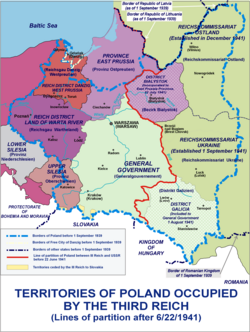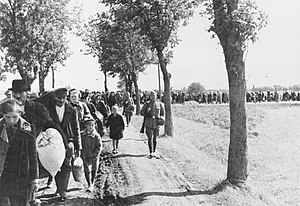Reichsgau Wartheland
The Reichsgau Wartheland (initially Reichsgau Posen, also Warthegau) was a Nazi German Reichsgau formed from parts of Polish territory annexed in 1939 during World War II.
It comprised the region of Greater Poland and adjacent areas. Parts of Warthegau matched the similarly named pre-Versailles Prussian province of Posen. The name was initially derived from the capital city, Posen (Poznań), and later from the main river, Warthe (Warta).
| Reichsgau Wartheland Warthegau | |||||||||
|---|---|---|---|---|---|---|---|---|---|
| Reichsgau of Nazi Germany | |||||||||
| 1939–1945 | |||||||||
 Map of Nazi conquest showing administrative subdivisions (Gaue and Reichsgaue) with Warthegau area (bright yellow, right).  Reichsgau Wartheland (burgundy) on the map of occupied Poland | |||||||||
| Capital | Posen | ||||||||
| Government | |||||||||
| Gauleiter | |||||||||
• 1939–1945 | Arthur Greiser | ||||||||
| History | |||||||||
| 8 October 1939 | |||||||||
| 1 August 1945 | |||||||||
| |||||||||
| Today part of | Poland | ||||||||
During the Partitions of Poland from 1793, the bulk of the area had been annexed by the Kingdom of Prussia until 1807 as South Prussia. From 1815 to 1849, the territory was within the autonomous Grand Duchy of Posen, which was the Province of Posen until Poland was re-established in 1918–1919 following World War I. The area is currently the Greater Poland Voivodeship.
Invasion and occupation of Poland

After the German Wehrmacht invaded Poland in September 1939, the German Reich occupied the whole of the Greater Poland area - the erstwhile Polish Poznań Voivodeship - and split the territory between four Reichsgaue and the General Government area (further east). The Militärbezirk Posen was created in September 1939; in accordance with a decree of 8 October 1939, Germany annexed it on 26 October 1939 as the Reichsgau Posen. SS Obergruppenfuhrer Arthur Greiser became Gauleiter on 21 October. He would remain in this post until the end of the war in 1945. Reichsgau Posen was renamed "Reichsgau Wartheland" on 29 January 1940.
In the new Reichsgau Posen the Wehrmacht established Wehrkreis XXI, based at Poznań (German: Posen), under the command of General der Artillerie Walter Petzel. Its primary operational unit was the 48th Panzer Korps, covering so-called Militärische Unterregion-Hauptsitze including Posen (Polish: Poznań), Lissa (Polish: Leszno), Hohensalza (Polish: Inowrocław), Leslau (Polish: Włocławek), Kalisch (Polish: Kalisz), and Litzmannstadt (Polish: Łódź). It maintained training areas at Sieradz and Biedrusko.
The territory of the Reichsgau was inhabited predominantly by ethnic Poles, by Germans (a minority of 16.7% in 1921), and by Polish Jews. Most of the Jewish residents were eventually imprisoned at the Łódź Ghetto (officially established in December 1939) and exterminated at Chełmno extermination camp (German: Vernichtungslager Kulmhof, operational from December 1941 onwards).
Characteristics

The Gauleiter and Reichsstatthalter of Reichsgau Wartheland, native-born Arthur Greiser, embarked on a program of complete removal of the formerly Polish citizenry upon his nomination by Heinrich Himmler. The plan also entailed the re-settling of ethnic Germans from the Baltic and other regions into farms and homes formerly owned by Poles and Jews. He also authorized the clandestine operation of exterminating 100,000 Polish Jews (about one-third of the total Jewish population of Wartheland), in the process of the region's complete "Germanization". In the first year of World War II, some 630,000 Poles and Jews were forcibly removed from Wartheland and transported to the occupied General Government (more than 70,000 from Poznań alone) in a series of operations called the Kleine Planung covering most Polish territories annexed by Germany at about the same time. Both Poles and Jews had their property confiscated.
By the end of 1940, some 325,000 Poles and Jews from the Wartheland and the Polish Corridor were expelled to General Government, often forced to abandon most of their belongings. Fatalities were numerous. In 1941, the Nazis expelled a further 45,000 people, and from autumn of that year, they began killing Jews by shooting and in gas vans, at first spasmodically and experimentally. Reichsgau Wartheland had the population: 4,693,700 by 1941. Greiser wrote in November 1942: "I myself do not believe that the Führer needs to be asked again in this matter, especially since at our last discussion with regard to the Jews he told me that I could proceed with these according to my own judgement."

End of war
By 1945 nearly half a million Germanic Volksdeutsche had been resettled in the Warthegau alone among the areas annexed by Germany while the Soviet forces began to push the retreating German forces back through the Polish lands. Most German residents along with over a million colonists fled westward. Some did not, due to restrictions by Germany's own government and the quickly advancing Red Army. An estimated 50,000 refugees died from the severe winter conditions, others as war atrocities committed by the Soviet military.[citation needed] The remaining ethnically German population was expelled to new Germany after the war ended.
See also
Notes
Sources
- Shoa.de - List of Gaue and Gauleiter (in German)
- Die NS Gaue at the Deutsches Historisches Museum website (in German)
- Die Gaue der NSDAP (in German)
Further reading
- Huener, Jonathan (University of Vermont) (March 2014). "Nazi Kirchenpolitik and Polish Catholicism in the Reichsgau Wartheland, 1939–1941". Central European History. 47 (1). Central European History Society of the American Historical Association: 105–137. doi:10.1017/S0008938914000648. S2CID 145194931. - DOI 10.1017/S0008938914000648, online publication on 15 May 2014
This article uses material from the Wikipedia English article Reichsgau Wartheland, which is released under the Creative Commons Attribution-ShareAlike 3.0 license ("CC BY-SA 3.0"); additional terms may apply (view authors). Content is available under CC BY-SA 4.0 unless otherwise noted. Images, videos and audio are available under their respective licenses.
®Wikipedia is a registered trademark of the Wiki Foundation, Inc. Wiki English (DUHOCTRUNGQUOC.VN) is an independent company and has no affiliation with Wiki Foundation.

